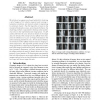Free Online Productivity Tools
i2Speak
i2Symbol
i2OCR
iTex2Img
iWeb2Print
iWeb2Shot
i2Type
iPdf2Split
iPdf2Merge
i2Bopomofo
i2Arabic
i2Style
i2Image
i2PDF
iLatex2Rtf
Sci2ools
CVPR
2003
IEEE
2003
IEEE
Clustering Appearances of Objects Under Varying Illumination Conditions
We introduce two appearance-based methods for clustering a set of images of 3-D objects, acquired under varying illumination conditions, into disjoint subsets corresponding to individual objects. The first algorithm is based on the concept of illumination cones. According to the theory, the clustering problem is equivalent to finding convex polyhedral cones in the high-dimensional image space. To efficiently determine the conic structures hidden in the image data, we introduce the concept of conic affinity which measures the likelihood of a pair of images belonging to the same underlying polyhedral cone. For the second method, we introduce another affinity measure based on image gradient comparisons. The algorithm operates directly on the image gradients by comparing the magnitudes and orientations of the image gradient at each pixel. Both methods have clear geometric motivations, and they operate directly on the images without the need for feature extraction or computation of pixel s...
Computer Vision | Convex Polyhedral Cones | CVPR 2003 | Illumination Conditions | Image Gradient Comparisons | Underlying Polyhedral Cone | Well-known Image Data |
| Added | 12 Oct 2009 |
| Updated | 12 Oct 2009 |
| Type | Conference |
| Year | 2003 |
| Where | CVPR |
| Authors | Jeffrey Ho, Ming-Hsuan Yang, Jongwoo Lim, Kuang-Chih Lee, David J. Kriegman |
Comments (0)

